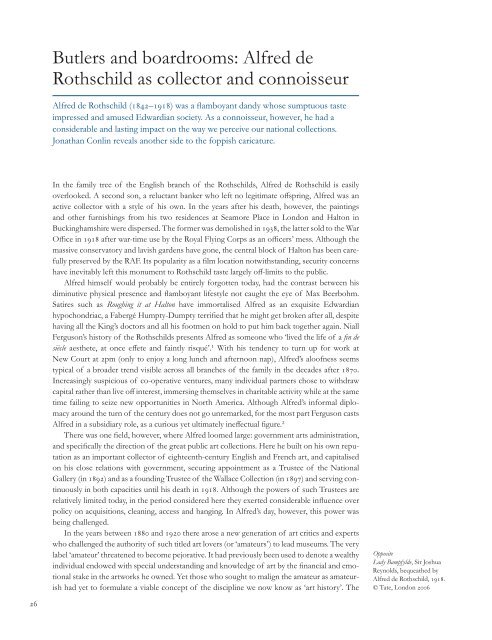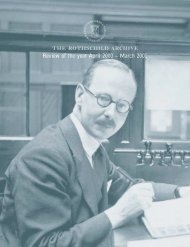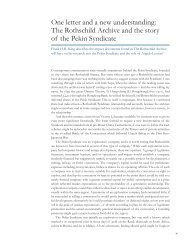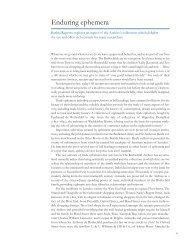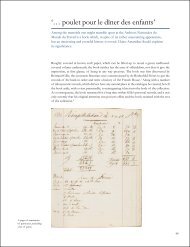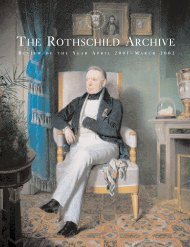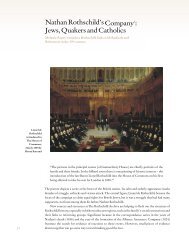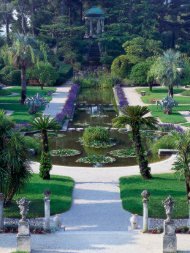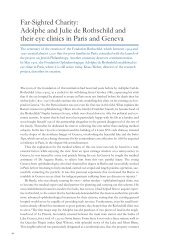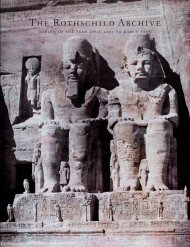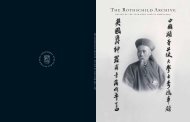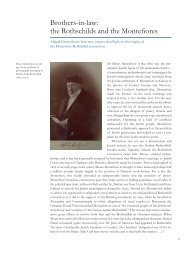Alfred de Rothschild as collector - The Rothschild Archive.
Alfred de Rothschild as collector - The Rothschild Archive.
Alfred de Rothschild as collector - The Rothschild Archive.
Create successful ePaper yourself
Turn your PDF publications into a flip-book with our unique Google optimized e-Paper software.
Butlers and boardrooms: <strong>Alfred</strong> <strong>de</strong><br />
<strong>Rothschild</strong> <strong>as</strong> <strong>collector</strong> and connoisseur<br />
<strong>Alfred</strong> <strong>de</strong> <strong>Rothschild</strong> (1842–1918) w<strong>as</strong> a flamboyant dandy whose sumptuous t<strong>as</strong>te<br />
impressed and amused Edwardian society. As a connoisseur, however, he had a<br />
consi<strong>de</strong>rable and l<strong>as</strong>ting impact on the way we perceive our national collections.<br />
Jonathan Conlin reveals another si<strong>de</strong> to the foppish caricature.<br />
In the family tree of the English branch of the <strong>Rothschild</strong>s, <strong>Alfred</strong> <strong>de</strong> <strong>Rothschild</strong> is e<strong>as</strong>ily<br />
overlooked. A second son, a reluctant banker who left no legitimate offspring, <strong>Alfred</strong> w<strong>as</strong> an<br />
active <strong>collector</strong> with a style of his own. In the years after his <strong>de</strong>ath, however, the paintings<br />
and other furnishings from his two resi<strong>de</strong>nces at Seamore Place in London and Halton in<br />
Buckinghamshire were dispersed. <strong>The</strong> former w<strong>as</strong> <strong>de</strong>molished in 1938, the latter sold to the War<br />
Office in 1918 after war-time use by the Royal Flying Corps <strong>as</strong> an officers’ mess. Although the<br />
m<strong>as</strong>sive conservatory and lavish gar<strong>de</strong>ns have gone, the central block of Halton h<strong>as</strong> been carefully<br />
preserved by the RAF. Its popularity <strong>as</strong> a film location notwithstanding, security concerns<br />
have inevitably left this monument to <strong>Rothschild</strong> t<strong>as</strong>te largely off-limits to the public.<br />
<strong>Alfred</strong> himself would probably be entirely forgotten today, had the contr<strong>as</strong>t between his<br />
diminutive physical presence and flamboyant lifestyle not caught the eye of Max Beerbohm.<br />
Satires such <strong>as</strong> Roughing it at Halton have immortalised <strong>Alfred</strong> <strong>as</strong> an exquisite Edwardian<br />
hypochondriac, a Fabergé Humpty-Dumpty terrified that he might get broken after all, <strong>de</strong>spite<br />
having all the King’s doctors and all his footmen on hold to put him back together again. Niall<br />
Ferguson’s history of the <strong>Rothschild</strong>s presents <strong>Alfred</strong> <strong>as</strong> someone who ‘lived the life of a fin <strong>de</strong><br />
siècle aesthete, at once effete and faintly risqué’. ₁ With his ten<strong>de</strong>ncy to turn up for work at<br />
New Court at 2pm (only to enjoy a long lunch and afternoon nap), <strong>Alfred</strong>’s aloofness seems<br />
typical of a broa<strong>de</strong>r trend visible across all branches of the family in the <strong>de</strong>ca<strong>de</strong>s after 1870.<br />
Incre<strong>as</strong>ingly suspicious of co-operative ventures, many individual partners chose to withdraw<br />
capital rather than live off interest, immersing themselves in charitable activity while at the same<br />
time failing to seize new opportunities in North America. Although <strong>Alfred</strong>’s informal diplomacy<br />
around the turn of the century does not go unremarked, for the most part Ferguson c<strong>as</strong>ts<br />
<strong>Alfred</strong> in a subsidiary role, <strong>as</strong> a curious yet ultimately ineffectual figure.²<br />
<strong>The</strong>re w<strong>as</strong> one field, however, where <strong>Alfred</strong> loomed large: government arts administration,<br />
and specifically the direction of the great public art collections. Here he built on his own reputation<br />
<strong>as</strong> an important <strong>collector</strong> of eighteenth-century English and French art, and capitalised<br />
on his close relations with government, securing appointment <strong>as</strong> a Trustee of the National<br />
Gallery (in 1892) and <strong>as</strong> a founding Trustee of the Wallace Collection (in 1897) and serving continuously<br />
in both capacities until his <strong>de</strong>ath in 1918. Although the powers of such Trustees are<br />
relatively limited today, in the period consi<strong>de</strong>red here they exerted consi<strong>de</strong>rable influence over<br />
policy on acquisitions, cleaning, access and hanging. In <strong>Alfred</strong>’s day, however, this power w<strong>as</strong><br />
being challenged.<br />
In the years between 1880 and 1920 there arose a new generation of art critics and experts<br />
who challenged the authority of such titled art lovers (or ‘amateurs’) to lead museums. <strong>The</strong> very<br />
label ‘amateur’ threatened to become pejorative. It had previously been used to <strong>de</strong>note a wealthy<br />
individual endowed with special un<strong>de</strong>rstanding and knowledge of art by the financial and emotional<br />
stake in the artworks he owned. Yet those who sought to malign the amateur <strong>as</strong> amateurish<br />
had yet to formulate a viable concept of the discipline we now know <strong>as</strong> ‘art history’. <strong>The</strong><br />
Opposite<br />
Lady Bampfyl<strong>de</strong>, Sir Joshua<br />
Reynolds, bequeathed by<br />
<strong>Alfred</strong> <strong>de</strong> <strong>Rothschild</strong>, 1918.<br />
© Tate, London 2006<br />
26
<strong>The</strong> Bampfyl<strong>de</strong> Room<br />
at Halton, <strong>Alfred</strong>’s dining<br />
room.<br />
relationship between the skills and knowledge <strong>as</strong>sociated with this ‘science’ and that practical<br />
knowledge of art technique <strong>as</strong>sociated with professional artists w<strong>as</strong> ill-<strong>de</strong>fined. <strong>The</strong> result w<strong>as</strong><br />
a surprisingly fluid, three-way struggle which lent the <strong>de</strong>bates surrounding museums, aca<strong>de</strong>mies<br />
and exhibitions a venomous fierceness – <strong>as</strong> well <strong>as</strong> making them of great interest to the historian<br />
interested in the role of the state, aristocracy and middle cl<strong>as</strong>s in shaping and policing i<strong>de</strong><strong>as</strong><br />
of national culture. At the centre of these <strong>de</strong>bates we discover another <strong>Alfred</strong> from that <strong>de</strong>picted<br />
by Beerbohm: combative, p<strong>as</strong>sionate, infuriating, stubborn – anything but ornamental.<br />
<strong>Alfred</strong>’s interest in Old M<strong>as</strong>ter paintings seems to have started young, and it appears that he<br />
w<strong>as</strong> personally involved in acquiring several of the paintings in the collection of his father,<br />
Lionel, who died in 1879. His time at Cambridge w<strong>as</strong> brief (1861–62) and undistinguished. Only<br />
three letters home from Cambridge survive among the papers in <strong>The</strong> <strong>Rothschild</strong> <strong>Archive</strong>, and<br />
none of them mentions study.³ Although there is no evi<strong>de</strong>nce to suggest a wild youth, <strong>Alfred</strong><br />
seems to have had difficulty finding something to occupy himself with. He dutifully fulfilled<br />
expectations by following his father and el<strong>de</strong>r brother into the family bank and w<strong>as</strong> even elected<br />
a Director of the Bank of England in 1868, the first Jew to hold the office. Fortunately wealth<br />
provi<strong>de</strong>d opportunities to build fabulous homes, beginning with Seamore Place, completed in<br />
1876 and followed by the sumptuous ple<strong>as</strong>ure palace of Halton, built to <strong>de</strong>signs by William<br />
Rogers in 1882–8. And homes needing furnishing, with art, and with guests.<br />
His collection began with the 38 predominately Dutch paintings inherited from his father,<br />
and numbered more than 200 works at his <strong>de</strong>ath. A significant proportion of the collection w<strong>as</strong><br />
acquired in two blocks, in June 1885 and October 1907: a group of eighteenth-century French<br />
works bought from the Earl of Lonsdale and 28 pictures from Lord Ashburton’s collection<br />
respectively. <strong>The</strong> latter group inclu<strong>de</strong>d six works now in the Metropolitan, New York, including<br />
three Rembrandts.⁴ Other works, notably the English portraits, were acquired piecemeal<br />
from other aristocrats, who appreciated the tactful discretion which marked <strong>Alfred</strong>’s collecting,<br />
<strong>as</strong>, in<strong>de</strong>ed, it did that of many other <strong>Rothschild</strong>s. He appears to have had strong suspicions of<br />
<strong>de</strong>alers, a situation which came to a head when he used his position <strong>as</strong> a Bank of England<br />
Director to find out how much a <strong>de</strong>aler had profited from selling on a painting bought from<br />
<strong>Rothschild</strong> himself. This abuse forced his resignation from the bank in 1889, and doubtless<br />
explains the slightly ludicrous telegram he later sent to the National Gallery board from Monte<br />
Carlo, insisting that ‘it would be a great mistake … to purch<strong>as</strong>e pictures from <strong>de</strong>alers’.⁵<br />
A 1973 study of <strong>Alfred</strong>’s t<strong>as</strong>te conclu<strong>de</strong>d that his collection w<strong>as</strong> ‘truly eccentric’. ₆ That is<br />
going a little too far. His t<strong>as</strong>te for seventeenth-century Dutch m<strong>as</strong>ters, for Reynolds and<br />
28
Gainsborough w<strong>as</strong> if anything a throwback to the t<strong>as</strong>te of Sir Robert Peel and other connoisseurs<br />
of fifty years before. In 1916, when the Gallery seriously consi<strong>de</strong>red selling off some of<br />
Peel’s collection of Dutch paintings (acquired in 1871), <strong>Alfred</strong> protested strongly that they were<br />
‘gems’.⁷ To that extent his t<strong>as</strong>te w<strong>as</strong> ‘unreconstructed’, not le<strong>as</strong>t in preferring Guardis and<br />
Seicento works to the earlier Quattrocento Italians rediscovered earlier in the century. His purch<strong>as</strong>e<br />
of a highly questionable Titian belonging to the 2nd Lord Methuen for £3,500 (Toilet of Venus,<br />
now Courtauld Gallery) suggests that his eye for Italians w<strong>as</strong> less than acute.<br />
In buying eighteenth-century French art <strong>Alfred</strong> w<strong>as</strong> more in tune with his times, the<br />
Goncourt Brothers having attracted renewed attention to this school. His interest earned him<br />
the honour of being appointed one of the founding Trustees of the Wallace Collection by Lady<br />
Wallace, a duty he clearly took very seriously. <strong>Alfred</strong> sat on the official committee which in 1897<br />
consi<strong>de</strong>red the question of where and how the Wallace Bequest should be housed, opposing<br />
plans to move the collection to a new annexe to be built on the Hampton Site contiguous to<br />
the National Gallery. <strong>Alfred</strong> saw the Wallace paintings, furnishings and armour <strong>as</strong> a Gesamtkunstwerk,<br />
fearing that a more scholarly arrangement would prevent visitors from admiring the<br />
t<strong>as</strong>te with which Sir Richard Wallace had arranged his possessions. At the same time he insisted<br />
on the installation of electric lighting, donating several electric torchieres. Such illumination had<br />
been laid on at Halton, but w<strong>as</strong> almost unheard of in public galleries. He also had the gilding<br />
on the furniture and frames renewed, something which struck many <strong>as</strong> vulgar.⁸<br />
An enthusi<strong>as</strong>m for paintings of attractive women clearly played a significant role in guiding<br />
<strong>Alfred</strong>’s t<strong>as</strong>te, <strong>as</strong> seen in the coquettish Reynolds portrait of Miss Angelo (1770, acquired by 1884)<br />
and in the sultry portraits of pubescent girls by Greuze. <strong>Alfred</strong> owned several examples of<br />
these, unsuccessfully attempting to acquire yet one more from Sir Richard Wallace in 1875,<br />
when he offered to swap it for some Sèvres porcelain.⁹ As a Trustee he would infuriate a succession<br />
of Gallery Directors by opposing the purch<strong>as</strong>e of works <strong>de</strong>picting women he thought<br />
ugly or plain, even when painted by artists of which he approved, such <strong>as</strong> Bronzino.<br />
Collecting for <strong>Alfred</strong> w<strong>as</strong> primarily about furnishing the walls of his resi<strong>de</strong>nces, something<br />
that might lead us to belittle his t<strong>as</strong>te. In fact, the paintings were the focus of the spaces he created<br />
for himself and his guests, <strong>as</strong> is shown by the way he named rooms after the painters whose<br />
works hung there, or even after a specific painting, <strong>as</strong> seen in the ‘Bampfyl<strong>de</strong> Room’ at Halton,<br />
where the eponymous portrait (1776) by Reynolds hung. ₁ ⁰ <strong>The</strong>se paintings were the backdrop<br />
to the opulent entertainments <strong>Alfred</strong> put on for his guests at Halton. As <strong>Alfred</strong>’s guest book<br />
attests, ₁₁ these hailed not only from the political and aristocratic elite, but also from the stage,<br />
Roughing it at Halton, Sir<br />
Max Beerbohm’s view of<br />
<strong>Alfred</strong> <strong>de</strong> <strong>Rothschild</strong>.<br />
Far right<br />
<strong>Alfred</strong> <strong>de</strong> <strong>Rothschild</strong>,<br />
Julius Luz.<br />
29
professional sport and the gossip columns. Some visitors, such <strong>as</strong> the 27th Earl of Crawford,<br />
found the rich Louis Quinze furnishings overdone and <strong>Alfred</strong>’s performances in his private<br />
circus vulgar. <strong>The</strong> majority admired the gilt and applau<strong>de</strong>d the antics of Milsom Rees, a m<strong>as</strong>ter<br />
at chicken mesmerising, an art now sadly neglected. ₁ ²<br />
It w<strong>as</strong>n’t just Rees’ hens that were hypnotised by <strong>Alfred</strong>’s wealth – the Earl of Rosebery w<strong>as</strong>,<br />
too. To those Liberals <strong>de</strong>sperate to find an act to follow Gladstone, Rosebery emanated an aura<br />
of youthful promise foreshadowing that which would later smother Anthony E<strong>de</strong>n. When<br />
Rosebery married into the <strong>Rothschild</strong> clan in 1878, <strong>Alfred</strong> and his brothers seemed to have<br />
gained a useful tool. In terms of foreign policy, Ferguson h<strong>as</strong> suggested that they got little leverage<br />
out of this union. ₁ ³ In terms of museum policy, the story is rather different, and the <strong>Alfred</strong>-<br />
Rosebery relationship takes us to the heart of that conflict between ‘old’ connoisseurship and<br />
‘new’ curatorship in which <strong>Alfred</strong> played such a key role.<br />
In the mid-1850s the National Gallery had un<strong>de</strong>rgone a series of reforms, which inclu<strong>de</strong>d<br />
an 1855 Tre<strong>as</strong>ury Minute creating the post of Gallery Director. <strong>The</strong> Minute gave the first<br />
Director (Charles E<strong>as</strong>tlake) a ring-fenced purch<strong>as</strong>e grant and instructed him to use it to fill<br />
those ‘gaps’ which prevented the nation’s collection from serving <strong>as</strong> a ‘complete’ history of art.<br />
A practising painter and Presi<strong>de</strong>nt of the Royal Aca<strong>de</strong>my, E<strong>as</strong>tlake w<strong>as</strong> also a scholar in touch<br />
with the latest German scholarship, which emph<strong>as</strong>ised archival research and close stylistic<br />
comparisons. He ma<strong>de</strong> use of his powers to travel wi<strong>de</strong>ly across Europe, greatly enriching the<br />
Gallery’s holdings, especially those of Quattrocento paintings that Trustees such <strong>as</strong> Peel had<br />
previously disdained <strong>as</strong> curiosities of little aesthetic value.<br />
Subsequent Directors en<strong>de</strong>avoured to follow E<strong>as</strong>tlake’s example, even while they faced<br />
incre<strong>as</strong>ing competition from European galleries and tighter restrictions on export of art works<br />
from Italian states. Meanwhile the Trustees accepted their advisory role. Thanks to falling grain<br />
prices and the introduction of heavier <strong>de</strong>ath duties in the final <strong>de</strong>ca<strong>de</strong>s of the century however,<br />
many of the great lan<strong>de</strong>d collections started to hit the London art markets. German and especially<br />
American industrial magnates were keen to buy the trappings of old money, driving up<br />
prices against museums incre<strong>as</strong>ingly concerned at the loss of m<strong>as</strong>terpieces abroad. Lobbying<br />
for special Tre<strong>as</strong>ury grants placed an incre<strong>as</strong>ed bur<strong>de</strong>n on Trustees, whose profile and sense of<br />
responsibility naturally grew. <strong>Alfred</strong>’s first t<strong>as</strong>te of such activity came in 1884, when he involved<br />
himself in the state’s efforts to acquire works from the Blenheim Sale. In 1890 he donated<br />
£10,000 towards the Gallery’s purch<strong>as</strong>e of Holbein’s Amb<strong>as</strong>sadors from the Earl of Radnor. ₁ ⁴<br />
Although he w<strong>as</strong> known <strong>as</strong> a <strong>collector</strong>, at the time of his appointment to the National<br />
Gallery board in 1892 <strong>Alfred</strong> appears to have been a peripheral figure. In convincing Prime<br />
Seamore Place, from<br />
<strong>Alfred</strong>’s privately produced<br />
gui<strong>de</strong> to his collection.<br />
<strong>Alfred</strong> wrote in the preface,<br />
‘<strong>The</strong> principal objects, and<br />
those which, needless to<br />
say, I most prize, I<br />
inherited from my <strong>de</strong>arly<br />
beloved father, and, in<br />
addition to the great<br />
ple<strong>as</strong>ure which they afford<br />
me, they constantly remind<br />
me of his most perfect<br />
judgement and t<strong>as</strong>te’.<br />
30
Halton House, <strong>Alfred</strong>’s<br />
Buckinghamshire estate<br />
shortly after completion.<br />
Minister Rosebery to frame a second Tre<strong>as</strong>ury Minute two years later, however, he became a<br />
central and controversial one. <strong>The</strong> ‘Rosebery Minute’ of 1894 re<strong>de</strong>fined the Trustee/Director<br />
relationship, curtailing the latter’s power to buy on his own authority and incre<strong>as</strong>ing the Board’s<br />
power. <strong>Alfred</strong> candidly admitted at a board meeting that this had been his i<strong>de</strong>a, that ‘the change<br />
in the terms of the Director’s appointment had been suggested by himself after consultation<br />
with Lord Rosebery’. ₁ ⁵ Three years later at the Wallace Collection <strong>Alfred</strong> and his fellow Trustees<br />
similarly succee<strong>de</strong>d in convincing Downing Street to restrict the powers of the first Keeper, the<br />
critic Clau<strong>de</strong> Phillips. ₁₆<br />
<strong>The</strong> appointment in 1894 of E.J. Poynter to the now much-weakened Directorship drew a<br />
line un<strong>de</strong>r a particularly difficult selection process, which had seen Poynter’s claims <strong>as</strong> a practising<br />
artist pitted against the scholarly ones of Sidney Colvin, Keeper of Prints and Drawings<br />
at the British Museum. <strong>The</strong> knowledge of foreign galleries and history vaunted by Colvin w<strong>as</strong><br />
<strong>de</strong>ri<strong>de</strong>d <strong>as</strong> ‘archaeological criticism’ or ‘mere antiquarianism’ by opponents, who inclu<strong>de</strong>d leading<br />
artists such <strong>as</strong> Holman Hunt and Burne Jones. ₁ ⁷ <strong>The</strong> new scholarship’s b<strong>as</strong>is on German<br />
foundations ma<strong>de</strong> it seem part of a foreign plot to replace connoisseur values with a pseudoscientific<br />
discipline that mingled dry theory with a weakness for the latest artistic fads. At a time<br />
when the ‘New Art Criticism’ of D.S. MacColl and Frank Rutter w<strong>as</strong> helping to fuel interest in<br />
shocking new phenomena such <strong>as</strong> Impressionism and Whistler’s ‘arrangements’, faddism w<strong>as</strong> a<br />
serious charge in<strong>de</strong>ed.<br />
<strong>Alfred</strong> followed up the Minute with a series of campaigns that ma<strong>de</strong> it next to impossible<br />
for Directors to continue filling ‘gaps’ <strong>as</strong> E<strong>as</strong>tlake had done. Between 1895 and 1902 he regularly<br />
attacked Poynter’s acquisition of what he saw <strong>as</strong> a series of overpriced works by secondary<br />
m<strong>as</strong>ters. ₁ ⁸ This <strong>de</strong>spite the fact that he w<strong>as</strong> often physically absent from meetings. His ability<br />
to make his views known even at a distance w<strong>as</strong> b<strong>as</strong>ed partly on a series of strongly-wor<strong>de</strong>d,<br />
professionally printed memoranda, which he first sprung on the Board in 1897. <strong>The</strong>se connoisseurial<br />
manifestoes were rammed home by his allies on the board, above all Lord Re<strong>de</strong>sdale and<br />
the 5th Marquis of Lansdowne, whose pro-German foreign policy views ma<strong>de</strong> him a natural<br />
partner. <strong>The</strong>se fellow Trustees also ma<strong>de</strong> life difficult for Poynter, publishing their own broadsi<strong>de</strong>s<br />
and further restricting his powers by the ‘Lansdowne Resolutions’ of 1902. That Poynter<br />
w<strong>as</strong> able to remain <strong>as</strong> Director until 1904 in the face of <strong>Rothschild</strong>’s campaign w<strong>as</strong> largely due<br />
to the continued support of a renega<strong>de</strong> Trustee, the 9th Earl of Carlisle. Poynter’s successor,<br />
Charles Holroyd, broke down un<strong>de</strong>r the strain, <strong>as</strong> <strong>Rothschild</strong>’s arrogance w<strong>as</strong> compoun<strong>de</strong>d by<br />
the arrival on the board of Curzon, a famously proud aristocrat who plumed himself on his eye<br />
for administrative <strong>de</strong>tail and who shared <strong>Alfred</strong>’s low opinion of Holroyd.<br />
<strong>Alfred</strong>’s petulant opposition to the acquisition of works by less renowned m<strong>as</strong>ters gave way<br />
31
to enthusi<strong>as</strong>m, generosity and inventiveness when it w<strong>as</strong> a question of scraping together funds<br />
to secure the limited number of first-rate m<strong>as</strong>terpieces he thought the Gallery should concentrate<br />
on. In 1909 <strong>Rothschild</strong> expressed his support for the i<strong>de</strong>a of a Reserve Purch<strong>as</strong>e Fund. He<br />
also drafted a letter that he suggested could be sent to the owners of key m<strong>as</strong>terpieces, <strong>as</strong>king<br />
them to give the Gallery first refusal in event of a sale. Both were i<strong>de</strong><strong>as</strong> consi<strong>de</strong>red by the 1913<br />
Curzon Committee, which tackled the whole issue of art sales abroad. ₁ ⁹ Art critics like D.S.<br />
MacColl had used the power of the press to draw public attention to the issue, and were among<br />
the founding fathers of the National Art Collections Fund established in 1903. <strong>Rothschild</strong><br />
welcomed public participation in the ‘rescue’ campaigns organized by the NACF, which began<br />
in 1906 with that to save Velazquez’ Rokeby Venus.<br />
Far from seeing them <strong>as</strong> exceptional, <strong>de</strong>sperate efforts by outsi<strong>de</strong>rs to compensate for the<br />
failure of the Establishment to act (<strong>as</strong> MacColl and his allies did), if anything such public campaigns<br />
fuelled a certain complacency in <strong>Alfred</strong>’s thought on acquisitions policy. Together with<br />
a re<strong>as</strong>suringly high price tag, such outcry w<strong>as</strong> a valuable way of checking that the Gallery w<strong>as</strong><br />
going after the right works. No expertise or powers to buy abroad were nee<strong>de</strong>d here. In his<br />
eagerness to keep it out of the hands of ‘so called experts’ <strong>Alfred</strong> seemed willing to outsource<br />
acquisition policy to the great British public, even if that ran the risk of pan<strong>de</strong>ring to public<br />
t<strong>as</strong>te, rather than educating it. As he wrote to fellow Trustee Viscount D’Abernon in 1909 ‘I<br />
think that whatever the National Gallery buys ought to possess such undoubted merit and<br />
attractiveness, that the verdict of the public would be unanimous in approving of our purch<strong>as</strong>es<br />
…’²⁰ This may explain his fierce opposition to exhibiting the Impressionist and Post-<br />
Impressionist collection of Hugh Lane at the Tate. Manet and Renoir’s work, <strong>Alfred</strong> fumed,<br />
‘would disgrace the one-armed man who chalks on the flagstones of the streets’.² ₁ Here, <strong>as</strong> with<br />
his preference for ‘attractive’ women in paintings, he w<strong>as</strong> guilty of failing to reconsi<strong>de</strong>r his own<br />
t<strong>as</strong>te, or make a distinction between its <strong>de</strong>mands and the wi<strong>de</strong>r criteria that necessarily held in<br />
consi<strong>de</strong>ring acquisitions for a national collection.<br />
<strong>Alfred</strong>’s disdain for the experience and knowledge of curators could take rather patronising<br />
forms. One Keeper of the Gallery who survived <strong>Alfred</strong> only to quit the Gallery in 1932 in disgust<br />
at continued Trustee arrogance w<strong>as</strong> Charles Collins Baker. After his <strong>de</strong>parture he p<strong>as</strong>sed<br />
on his recollections to his friend, the well-known critic and Keeper (1911–24) of the Wallace<br />
Collection D.S. MacColl. <strong>The</strong> following account mingles Collins Baker’s own memories with<br />
those of a pre<strong>de</strong>cessor, George Ambrose, providing one final insight into just how <strong>de</strong>eply<br />
etched into the Gallery’s collective consciousness this particular Trustee’s behaviour w<strong>as</strong>:<br />
Archibald Primrose,<br />
5th Earl of Rosebery<br />
(1847–1929) husband of<br />
Hannah <strong>de</strong> <strong>Rothschild</strong>.<br />
Ambrose … recounted over and over again how once A. <strong>Rothschild</strong> had turned on Hawes<br />
Turner [the Keeper], who had been sticking up for the Lane Collection, and in the<br />
presence of the rest had told him (Turner) not to go miaowing about the place like a cat:<br />
and A.<strong>de</strong> R. (to Ambrose’s great <strong>de</strong>light) had given an imitation of Hawes Turner’s voice,<br />
travestied with ‘miaows’. In no time I began to see for myself. In full meeting A.<strong>de</strong> R.<br />
referring to Holroyd, said if he were one’s butler and brought up a corked bottle of wine<br />
one would spit it out: and he gave another excellent imitation (on my right sleeve) of<br />
expelling corked wine. This w<strong>as</strong> apropos of Holroyd submitting a picture which A.<strong>de</strong> R.<br />
thought ugly.<br />
<strong>The</strong> whole atmosphere, he continued w<strong>as</strong> one of ‘<strong>de</strong> haut en b<strong>as</strong>, contempt of scholarship’,<br />
meekly accepted by the staff.²²<br />
Even after <strong>Alfred</strong>’s <strong>de</strong>mise in 1918 the mo<strong>de</strong>l of heavily ormulu’d Trusteeship he had introduced<br />
lived on until the Second World War. During the 1920s and 1930s the Board w<strong>as</strong><br />
thronged with other dandies and incroyables noted for their exquisite f<strong>as</strong>hion and opulent entertaining.<br />
Among these w<strong>as</strong> Philip S<strong>as</strong>soon, also of Jewish extraction. Actually, S<strong>as</strong>soon w<strong>as</strong> a<br />
relative of <strong>Alfred</strong>’s; his mother Aline w<strong>as</strong> born a <strong>Rothschild</strong>.<br />
32
Even after the foundation of the Courtauld Institute in 1930 ‘art history’ continued to elicit<br />
wi<strong>de</strong>spread suspicion. Connoisseurship, high prices and popular appeal continued to <strong>de</strong>fine the<br />
sort of art that ‘belonged’ in a national collection. High art remained yoked to prestige and<br />
wealth, the museum continued to be seen <strong>as</strong> a marble palace. This, rather than circuses or<br />
Reynolds portraits w<strong>as</strong> <strong>Alfred</strong>’s legacy to the nation. For him, the museum w<strong>as</strong> just another<br />
stage. Here, <strong>as</strong> at Halton, he ma<strong>de</strong> the butlers and the pretty ladies dance.<br />
Jonathan Conlin h<strong>as</strong> published a number of articles on eighteenth- and nineteenth-century British cultural<br />
history, and teaches British History at Southampton University. His first book, <strong>The</strong> Nation’s<br />
Mantelpiece: A History of the National Gallery, 1824–1974 (Pall<strong>as</strong> Athene) will appear in<br />
October 2006.<br />
notes<br />
1 Niall Ferguson, <strong>The</strong> World’s Banker: <strong>The</strong><br />
History of the House of <strong>Rothschild</strong> (London:<br />
Wei<strong>de</strong>nfeld & Nicolson, 1998), p.744.<br />
2 Ibid., pp.744, 750–2, 758, 767–9, 873, 921.<br />
3 ral 000/40.<br />
4 Notes in <strong>Alfred</strong>’s Collector’s File in the<br />
Provenance In<strong>de</strong>x at the Getty Research<br />
Institute, Malibu claim that these were in<br />
fact security for a loan. Receipts preserved<br />
in the <strong>Archive</strong> dated 1907 and 1911<br />
suggest that the paintings might have been<br />
security for a loan between Asher<br />
Wertheimer and the 5th Baron Ashburton<br />
(Francis Denzil Baring, 1866–1938),<br />
although much remains unclear. ral<br />
000/174b, ff.33, 40 and 54.<br />
5 Telegram of 28 February 1896. National<br />
Gallery <strong>Archive</strong> [hereafter nga], Board<br />
Minutes, 3 March 1896.<br />
6 Nichol<strong>as</strong> D. <strong>de</strong> <strong>Rothschild</strong>, ‘<strong>Alfred</strong> <strong>de</strong><br />
<strong>Rothschild</strong> and the “R” Style’,<br />
(unpublished University of Cambridge<br />
BA <strong>The</strong>sis, 1973), <strong>Rothschild</strong> <strong>Archive</strong>,<br />
000/258. I am grateful to the author for<br />
kindly allowing me to consult this work,<br />
which I found most useful in preparing<br />
this piece.<br />
7 <strong>Alfred</strong> <strong>de</strong> <strong>Rothschild</strong> to C.H. Collins<br />
Baker, 22 June 1916. nga, ng26/101.<br />
8 See Report of Committee appointed by the<br />
Tre<strong>as</strong>ury to consi<strong>de</strong>r the housing of the collection of<br />
… the late Lady Wallace Cmnd. 8445 (1897),<br />
esp. q229 and q250. For the electroliers, see<br />
Wallace Collection <strong>Archive</strong>s [hereafter<br />
wca], Board Minutes, 1 May 1900. For<br />
reactions to gilding, see National <strong>Archive</strong>s<br />
of Scotland, gd510/1/45 and Gl<strong>as</strong>gow<br />
University Library, MacColl Papers, s451.<br />
<strong>The</strong> Wallace Board Minutes show <strong>Alfred</strong><br />
attending regularly, proposing ways of<br />
advertising the collection, introducing<br />
refreshment facilities and extending the<br />
hours.<br />
9 ‘I should doubly prize the little picture’,<br />
<strong>Alfred</strong> wrote, ‘<strong>as</strong> having belonged to a<br />
gentleman, who by his exquisite t<strong>as</strong>te and<br />
unboun<strong>de</strong>d popularity so well <strong>de</strong>serves to<br />
be the possessor of the finest collection of<br />
works of art in the world.’ <strong>Alfred</strong> <strong>de</strong><br />
<strong>Rothschild</strong> to Sir Richard Wallace, 31<br />
March 1875. wca, ar2/251.<br />
10 <strong>Alfred</strong> left this work to the National<br />
Gallery at his <strong>de</strong>ath. One Director of the<br />
Gallery (Sir Charles Holmes) would later<br />
express disappointment that <strong>Alfred</strong> chose<br />
to leave the rest of his collection (along<br />
with the Halton Estate) to his nephew,<br />
Lionel Nathan <strong>de</strong> <strong>Rothschild</strong>, who sold<br />
most of it off. It w<strong>as</strong>, he said, a cautionary<br />
tale against appointing millionaires <strong>as</strong><br />
Trustees in the hope that they would make<br />
large bequests. But full-length Reynolds<br />
portraits were at the top of the market at<br />
the time. Seen in this light, the bequest<br />
hardly seems stingy. Holmes to Curzon, 21<br />
March 1921. British Library, Oriental and<br />
India Office Library, mss eur f112/58.<br />
11 A transcript of the book is available at <strong>The</strong><br />
<strong>Rothschild</strong> <strong>Archive</strong>.<br />
12 For the hens, see Mrs Lionel <strong>de</strong><br />
<strong>Rothschild</strong>’s recollections, recor<strong>de</strong>d in 1970<br />
<strong>as</strong> part of Nichol<strong>as</strong> <strong>de</strong> <strong>Rothschild</strong>’s<br />
researches into <strong>Alfred</strong>’s t<strong>as</strong>te. ral 000/258.<br />
13 Ferguson, <strong>The</strong> World’s Banker, p.859.<br />
14 See William Gregory to <strong>Alfred</strong> <strong>de</strong><br />
<strong>Rothschild</strong>, 24 June 1884. ral 000/182, f.1.<br />
15 nga, Trustee Minutes, 4 February 1896.<br />
Some credit should also go to a Tre<strong>as</strong>ury<br />
official, G.H. Murray, who clearly played an<br />
equally important role in framing the<br />
minute. See his memo of 30 March 1894.<br />
National Library of Scotland, Rosebery<br />
Papers, 10150, f.186.<br />
16 Although some officials were on Phillips’<br />
si<strong>de</strong>, they did little to support him. See the<br />
correspon<strong>de</strong>nce of Phillips and Bernard<br />
Mallet in wca, ar50/d.<br />
17 See Carlisle to Gladstone, 19 February<br />
1894. National Library of Scotland,<br />
Rosebery Papers, 10150, f.110. <strong>The</strong> same<br />
volume contains many other letters on the<br />
issue from Burne Jones, Holman Hunt,<br />
Charles Fairfax Murray, Lord Leighton and<br />
others. See also Alan Bell, ‘Colvin vs.<br />
Poynter: the directorship of the National<br />
Gallery, 1892–4’, in Connoisseur (December<br />
1975), pp.278–83. While not opposed to<br />
Poynter, <strong>Alfred</strong>’s preferred candidate w<strong>as</strong><br />
Walter Armstrong, Director of the<br />
National Gallery of Ireland.<br />
18 For examples of <strong>Alfred</strong>’s opposition to<br />
specific pictures brought forward for<br />
consi<strong>de</strong>ration by Poynter see nga, Trustee<br />
Minutes, 10 December 1895 (over<br />
Parmigiano from Scarpa Collection,<br />
Milan), 14 April 1896 (over an ‘ugly’<br />
Bronzino) and 1 June 1897 (over Bettes’<br />
Portrait of a Man and M<strong>as</strong>olino Christ Among<br />
the Doctors). See Poynter to George<br />
Howard, 2 May 1896. C<strong>as</strong>tle Howard,<br />
Papers of the 9th Earl of Carlisle, J22/57.<br />
For Holroyd’s reaction to similar<br />
resistance, see bl, Oriental and India<br />
Office Library, mss eur f112/57.<br />
19 nga, Trustee Minutes, 7 July 1909. <strong>Alfred</strong><br />
clearly disagreed with the 1913 Curzon<br />
Reports findings. His initial refusal to sign<br />
the report ma<strong>de</strong> difficulties for Curzon. bl,<br />
Oriental and India Office Library, mss eur<br />
f112/62.<br />
20 <strong>Alfred</strong> <strong>de</strong> <strong>Rothschild</strong> to D’Abernon,<br />
5 November 1909. ral 000/182, f.23<br />
21 <strong>Alfred</strong> <strong>de</strong> <strong>Rothschild</strong>, printed memo, n.d.<br />
bl, Oriental and India Office Library, mss<br />
eur f112/64.<br />
22 George E. Ambrose served <strong>as</strong> Clerk from<br />
1878 to 1897 and Chief Clerk from<br />
1897–1914; Hawes Turner w<strong>as</strong> Keeper<br />
from 1898 until 1914. Collins Baker,<br />
‘Reflections and conclusions <strong>as</strong> regards the<br />
N.G.’ n.d.. Gl<strong>as</strong>gow University Library,<br />
D.S. MacColl Papers, b18. <strong>The</strong> episo<strong>de</strong>s<br />
<strong>de</strong>scribed must predate 1914.<br />
33


